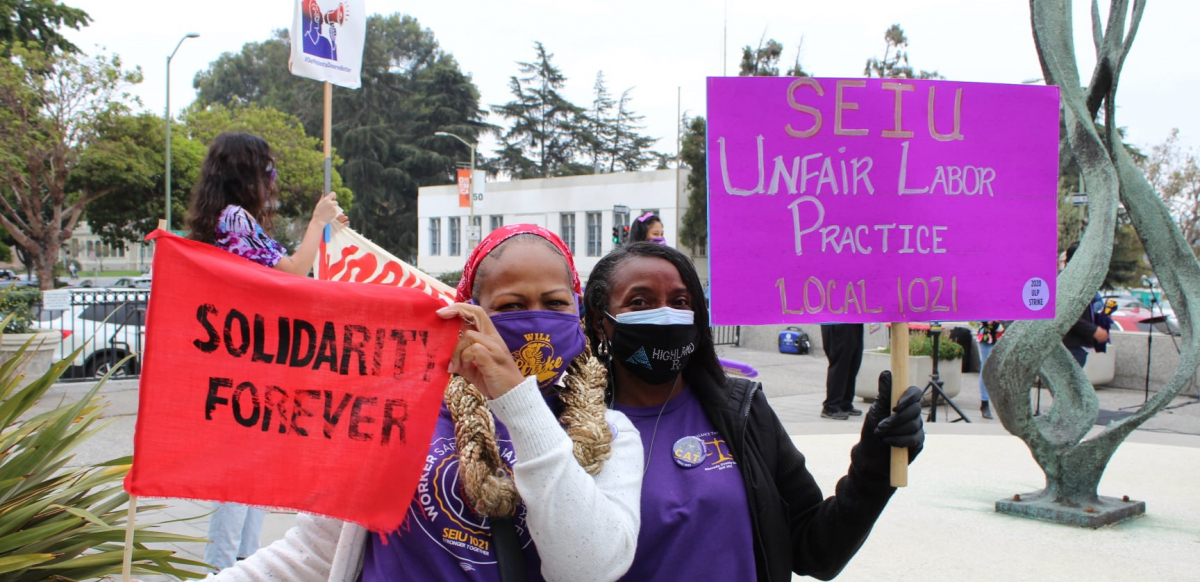What Are We Doing to Shift the Balance of Power at Work?

Members of SEIU Local 1021 rallied outside the Alameda County Administration Building during their October strike. Photo: SEIU Local 1021
The pandemic kicked workers back on their heels—even tumbled some over. Fearing for their lives and well-being, some responded with fire and organizing, others with stunned passivity.
At some moments it seemed that possibilities were opening up for powerful collective action: with bus drivers in Detroit striking and educators in New York City sicking out, and the Black liberation movement taking to the streets.
It looked like a transformational moment, but the possibilities are yet to be realized. Nine months into the pandemic, workers are overworked, overwhelmed, and exhausted.
SO MANY MEETINGS
During the past nine months I’ve been in lots of meetings. Labor leaders talking about how to fight for health and safety. Educators organizing to protect themselves, students, and public education. And, most recently, Labor Action to Defend Democracy, a network to prepare labor’s response in the event of an attempted coup.
These meetings are mostly well attended—as many unions are reporting as well. Whether it be the ease of Zoom or the urgency of the issues, people are showing up.
So, what do we do when people show up? What do we hope to accomplish? What can we accomplish?
I have struggled with this question. This year the way the structures of power really work was stripped bare. That invites a sense of possibility for coordinated work actions. The shared purpose and vision that emerge in meetings inspires me in an uncertain world.
I have an impulse to box these feelings up into a structure with a plan. Can’t I just transform this desire to connect into organizations that will promote the next upsurge?
Yet I have seen all too clearly the distance between the world we want and our power to claim that world.

SUPPORT LABOR NOTES
BECOME A MONTHLY DONOR
Give $10 a month or more and get our "Fight the Boss, Build the Union" T-shirt.
While unions passed resolutions to defend democracy, how many of the leaders who voted for those resolutions did what United Teachers Los Angeles did—went out and talked with members?
Educators in Brookline, Massachusetts used a one-day strike to win their demand for six feet between people in school buildings. That reminds me of how we build power, one step at a time. But sometimes that one step seems stunningly inadequate compared to all we need.
I do not know the answer to the question of what is possible right now. Time will tell—and what we do right now will matter. I do know that there is something to capture in the large numbers of workers looking to connect with each other, looking for a way out of this structured misery and to a better place.
WE BUILD RELATIONSHIPS
After each meeting, I find myself taking away the same lessons. We build relationships—which will last us for the long haul that is the arc of change. We teach each other how to do the work—to talk, to listen, to name power, and to activate our collective strength.
In meetings of labor activists, and even in my own head, a debate rages. Calls to build structures to lead massive work stoppages around shared demands compete with lessons about the smaller worksite actions needed to build labor’s muscle. More and more, I see this debate as a distraction.
The real question we should be asking each other is: what did you do today to bring workers together so that they are shifting the balance of power?
Let’s hold each other to each part of that question: how have workers come together and what did they do to shift the balance of power?
I suspect rigorous attention to these questions will lead us to the power and structures we need to win a better world.


